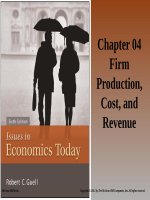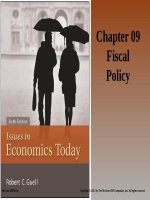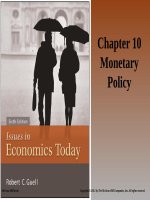Isues in economics today 6th by guell chapter03
Bạn đang xem bản rút gọn của tài liệu. Xem và tải ngay bản đầy đủ của tài liệu tại đây (229.47 KB, 39 trang )
Chapter 03
The Concept
of Elasticity
and
Consumer
and
Producer
Surplus
McGraw-Hill/Irwin
Copyright © 2012 by The McGraw-Hill Companies, Inc. All rights reserved.
McGraw-Hill/Irwin
Chapter Outline
• Elasticity of Demand
• Alternative Ways of Understanding
Elasticity
• More on Elasticity
• Consumer and Producer Surplus
• Kick It Up a Notch: Deadweight Loss
3-2
Elasticity
• Elasticity: the responsiveness of quantity to
a change in another variable
• Price Elasticity of Demand: the
responsiveness of quantity demanded to a
change in price
• Price Elasticity of Supply: the
responsiveness of quantity supplied to a
change in price
• Income Elasticity of Demand: the
responsiveness of quantity demanded to a
change in income
• Cross Price Elasticity of Demand: the
responsiveness of quantity demanded of one
good to a change in the price of another good
3-3
The Mathematical Representation
of Elasticity
ΔQ
%ΔQ
Q
Elasticity =
=
%ΔP
ΔP
P
Because the demand curve is downward sloping and
the supply curve is upward sloping the elasticity of
demand is negative and the elasticity of supply is
positive. Often these signs are implicit and ignored.
3-4
Elasticity Labels
• Elastic : the condition of demand when
the percentage change in quantity is larger
than the percentage change in price
• Inelastic: the condition of demand when
the percentage change in quantity is
smaller than the percentage change in
price
• Unitary Elastic: the condition of demand
when the percentage change in quantity is
equal to the percentage change in price
3-5
Alternative Ways to Understand
Elasticity
The Graphical Explanation
3-6
The Relationship Between Slope and
Elasticity
• Elasticity and the slope of the
demand curve are not the same but
they are related.
• At a given price level, elasticity is
greater with a flatter demand curve.
• With a linear demand curve
(meaning a demand curve that has
a single value for the slope)
elasticity is greater at higher prices.
3-7
Figure 1
12.5% change (9-8)/8
P 13
12
11
10
9
8
7
6
5
4
3
2
1
0
25% change (4-3)/4
D1
1 2 3 4 5 6 7 8 9 10 11 12 13
Q/t
3-8
Figure 2
50% change (12-8)/8
P 13
12
11
10
9
8
7
6
5
4
3
2
1
0
D2
25% change (4-3)/4
1 2 3 4 5 6 7 8 9 10 11 12 13
Q/t
3-9
Figure 3 Higher Prices Means Greater Elasticity
12.5% change (9-8)/8
P 13
12
11
10
9
8
7
6
5
4
3
2
1
0
50% change (3-2)/2
A
B
Demand
C
25% change (4-3)/4
D
1 2 3 4 5 6 7 8 9 10 11 12 13
9.1% change (11-10)/11
Q/t
3-10
Alternative Ways to Understand
Elasticity
The Verbal Explanation
• A good for which there are no good
substitutes is likely to be one for which you
must pay whatever price is charged. It is also
likely to be one for which a lower price will
not induce substantially greater consumption.
Thus, as price changes there is very little
change in consumption, i.e. demand is
inelastic and the demand curve is steep.
• Inexpensive goods that take up little of your
income can change in price and your
consumption will not change dramatically.
Thus, at low prices, demand is inelastic.
3-11
Seeing Elasticity Through Total
Expenditures
• Total Expenditure Rule: if the
price and the amount you spend
both go in the same direction then
demand is inelastic while if they go
in opposite directions demand is
elastic.
3-12
Determinants of Elasticity
• Number of and Closeness of Substitutes
• The more alternatives you have the less likely
you are to pay high prices for a good and the
more likely you are to settle for something that
will do.
• Time
• The longer you have to come up with
alternatives to paying high prices the more
likely it is you will shift to those alternatives.
• Portion of the Budget
• The greater the portion of the budget an item
takes up, the greater the elasticity is likely to
be.
3-13
Extremes of Elasticity
• Perfectly Inelastic: the condition
of demand when price changes
have no effect on quantity
• Perfectly Elastic: the condition of
demand when price cannot change
3-14
Elasticity and the Demand
Curve
How the Elasticity of
Demand Affects Reactions
to Price Changes
3-15
Figure 4 Perfectly Inelastic Demand
P
S2
P2
S1
P1
D
Q1=Q2
Q/t
3-16
Figure 5 Perfectly Elastic
Demand
P
S2
S1
P1=P2
D
Q2
Q1
Q/t
3-17
Figure 6 Inelastic Demand
P
(at moderate prices)
S2
S1
P2
P1
D
Q2
Q1
Q/t
3-18
Figure 7 Elastic Demand
P
(at moderate prices)
S2
S1
P2
P1
D
Q2
Q1
Q/t
3-19
Elasticity Examples
Inelastic Goods
Price Elasticity
Eggs
0.06
Food
0.21
Health Care Services
0.18
Gasoline (short-run)
0.08
Gasoline (long-run)
0.24
Highway and Bridge Tolls
0.10
Unit Elastic Good (or close to it)
Shellfish
0.89
Cars
1.14
Elastic Goods
Luxury Car
3.70
Foreign Air Travel
1.77
Restaurant Meals
2.27
3-20
Price Elasticity Supply
• Identical in concept to elasticity of
demand.
• Formula is the Same
• It is also related to the slope of
the supply curve but is not
simply the slope of the supply
curve.
• Terminology is the same
3-21
Perfectly Inelastic Supply
P
S
P2
P1
D2
D1
Q1=Q2
Q/t
3-22
Inelastic Supply
P
S
P2
P1
D2
D1
Q1
Q2
Q/t
3-23
Elastic Supply
P
S
P2
P1
D2
D1
Q1
Q2
Q/t
3-24
Perfectly Elastic Supply
P
P1=P2
S
D2
D1
Q1
Q2
Q/t
3-25









